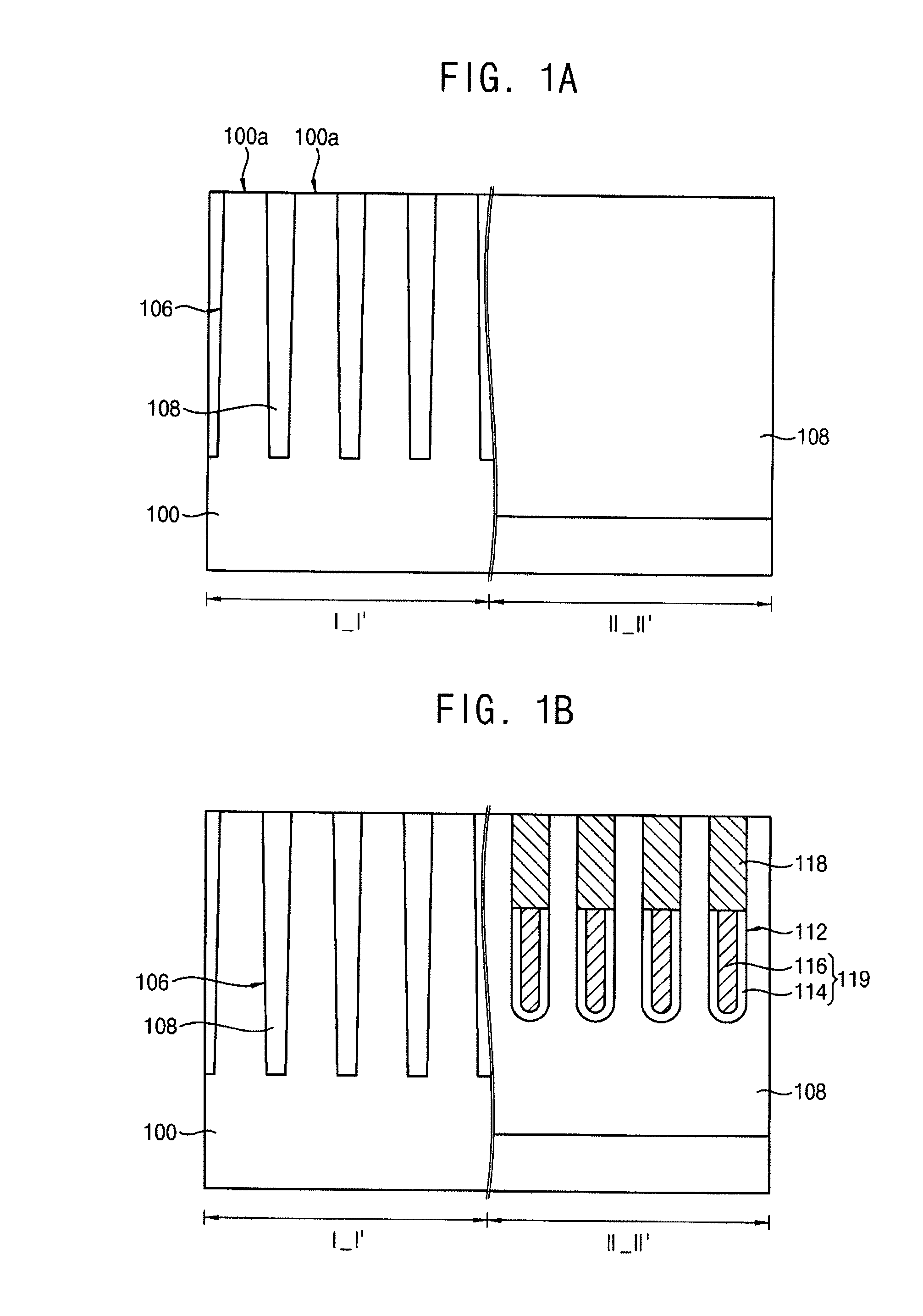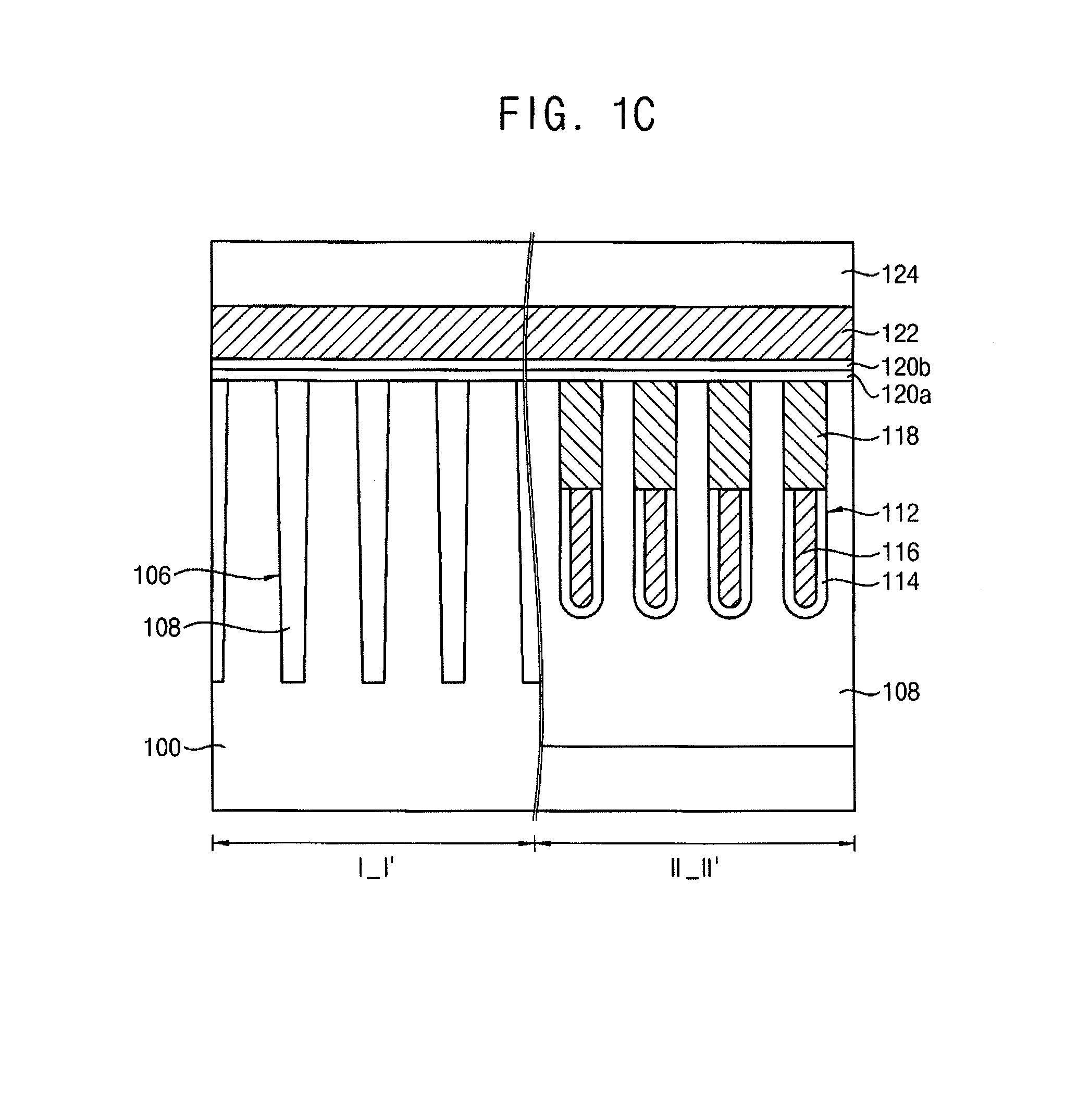Methods for fabricating a semiconductor device
a semiconductor and device technology, applied in the direction of semiconductor devices, electrical devices, transistors, etc., can solve the problems of increasing bridge defects between the contact and an adjacent pattern, or the gap between the contact and an adjacent active region increases
- Summary
- Abstract
- Description
- Claims
- Application Information
AI Technical Summary
Benefits of technology
Problems solved by technology
Method used
Image
Examples
example embodiment 1
[0043]FIGS. 1A to 1J illustrate cross-sectional views of stages in a method for fabricating a semiconductor device in accordance with an exemplary embodiment. FIGS. 2A to 2G are plan views corresponding to respective cross-sectional views.
[0044]In FIGS. 1A to 1J, the left-side cross-sectional views are taken along a line I-I′ in FIG. 2A, and the right-side cross-sectional views are taken along a line II-II′ in FIG. 2A. Hereinafter, the longitudinal direction of active regions may be called as a first direction, the extended direction of buried gate structures may be called as a second direction, and a perpendicular direction to the second direction may be called as a third direction.
[0045]Referring to FIGS. 1A and 2A, a hard mask pattern (not illustrated) for forming device isolating trenches may be formed in a substrate 100 including single crystalline silicon. The hard mask pattern may include silicon nitride.
[0046]The substrate 100 may be anisotropically etched by using the hard ...
example embodiment 2
[0084]FIGS. 3A to 3F illustrate cross-sectional views of stages in a method for fabricating a semiconductor device in accordance with an exemplary embodiment.
[0085]First, the structure illustrated in FIG. 1B may be formed on a substrate by conducting the processes explained referring to FIGS. 1A and 1B.
[0086]Referring to FIG. 3A, an insulating interlayer 160 may be formed on the substrate 100 including a buried gate electrode. The insulating interlayer 160 may include, e.g., silicon oxide.
[0087]Referring to FIG. 3B, a photoresist layer may be formed on the insulating interlayer 160. The photoresist layer may be patterned through a photo process to form the photoresist patterns 126. The photoresist patterns 126 may be formed so as to have an isolated shape defining portions of the second and third contact forming regions 110b and 110c (see FIG. 2) and the adjacent upper portion of the device isolating layer pattern 108. The shape of the photoresist pattern 126 may be the same as expl...
example embodiment 3
[0097]FIGS. 4A to 4G illustrate cross-sectional views of stages in a method for fabricating a semiconductor device in accordance with an exemplary embodiment. FIG. 5 is a plan view corresponding to the cross-sectional view in FIG. 4B.
[0098]First, the same processes explained referring to FIGS. 1A to 1C may be conducted. Then, a structure including the pad insulating layer, the etch stopping layer, the first conductive layer, and the sacrificial layer stacked on the substrate including the buried gate electrode, as illustrated in FIG. 1C, may be formed.
[0099]Referring to FIG. 4A, a first mask layer 204 may be formed on the sacrificial layer 124. The first mask layer 204 may include an amorphous carbon layer (ALC).
[0100]A first anti reflecting layer 206 may be formed on the first mask layer 204. The first anti reflecting layer 206 may include, e.g., silicon oxynitride. The first anti reflecting layer 206 may be provided as an adhesive layer for improving the adhesive properties of an ...
PUM
 Login to View More
Login to View More Abstract
Description
Claims
Application Information
 Login to View More
Login to View More - R&D
- Intellectual Property
- Life Sciences
- Materials
- Tech Scout
- Unparalleled Data Quality
- Higher Quality Content
- 60% Fewer Hallucinations
Browse by: Latest US Patents, China's latest patents, Technical Efficacy Thesaurus, Application Domain, Technology Topic, Popular Technical Reports.
© 2025 PatSnap. All rights reserved.Legal|Privacy policy|Modern Slavery Act Transparency Statement|Sitemap|About US| Contact US: help@patsnap.com



